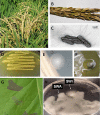Burkholderia glumae: next major pathogen of rice?
- PMID: 21453428
- PMCID: PMC6640401
- DOI: 10.1111/j.1364-3703.2010.00676.x
Burkholderia glumae: next major pathogen of rice?
Abstract
Burkholderia glumae causes bacterial panicle blight of rice, which is an increasingly important disease problem in global rice production. Toxoflavin and lipase are known to be major virulence factors of this pathogen, and their production is dependent on the TofI/TofR quorum-sensing system, which is mediated by N-octanoyl homoserine lactone. Flagellar biogenesis and a type III secretion system are also required for full virulence of B. glumae. Bacterial panicle blight is thought to be caused by seed-borne B. glumae; however, its disease cycle is not fully understood. In spite of its economic importance, neither effective control measures for bacterial panicle blight nor rice varieties showing complete resistance to the disease are currently available. A better understanding of the molecular mechanisms underlying B. glumae virulence and of the rice defence mechanisms against the pathogen would lead to the development of better methods of disease control for bacterial panicle blight.
Taxonomy: Bacteria; Proteobacteria; Betaproteobacteria; Burkholderiales; Burkholderiaceae; Burkholderia.
Microbiological properties: Gram-negative, capsulated, motile, lophotrichous flagella, pectolytic.
Disease symptoms: Aborted seed, empty grains as a result of failure of grain filling, brown spots on panicles, seedling rot.
Disease control: Seed sterilization, planting partially resistant lines (no completely resistant line is available). KNOWN VIRULENCE FACTORS: Toxoflavin, lipase, type III effectors.
© 2010 LSU AGCENTER. MOLECULAR PLANT PATHOLOGY © 2010 BSPP AND BLACKWELL PUBLISHING LTD.
Figures

References
-
- Alfano, J.R. and Collmer, A. (2004) Type III secretion system effector proteins: double agents in bacterial disease and plant defense. Annu. Rev. Phytopathol. 42, 385–414. - PubMed
-
- Bent, A.F. and Mackey, D. (2007) Elicitors, effectors, and R genes: the new paradigm and a lifetime supply of questions. Annu. Rev. Phytopathol. 45, 399–436. - PubMed
-
- Brenner, D.J. , Krieg, N.R. , Staley, J.T. and Garrity, G.M. (2005) Bergey's Manual of Systematic Bacteriology, 2nd edn. New York: Springer.
Publication types
MeSH terms
Substances
LinkOut - more resources
Full Text Sources
Other Literature Sources

